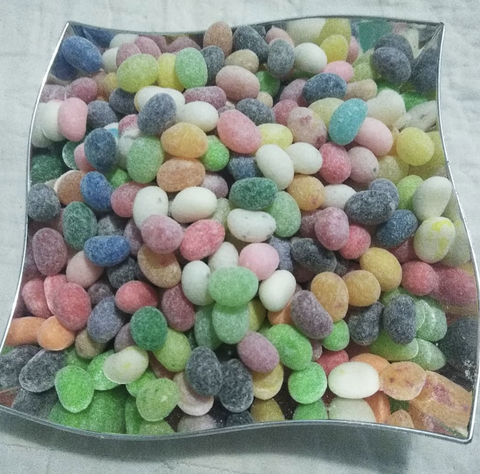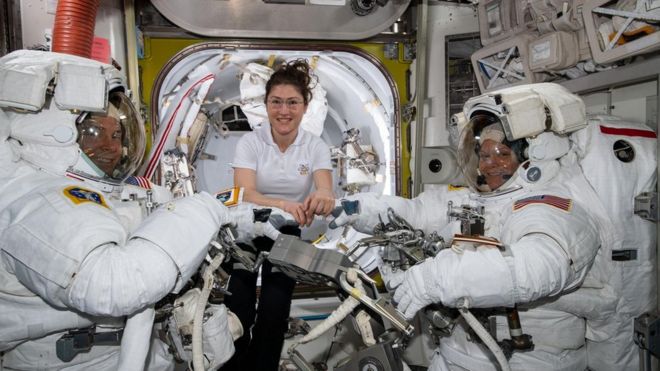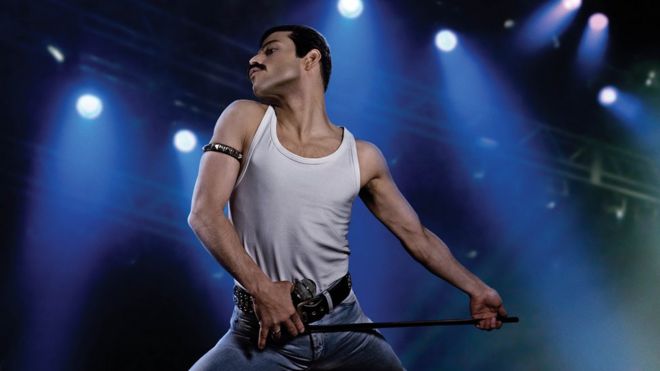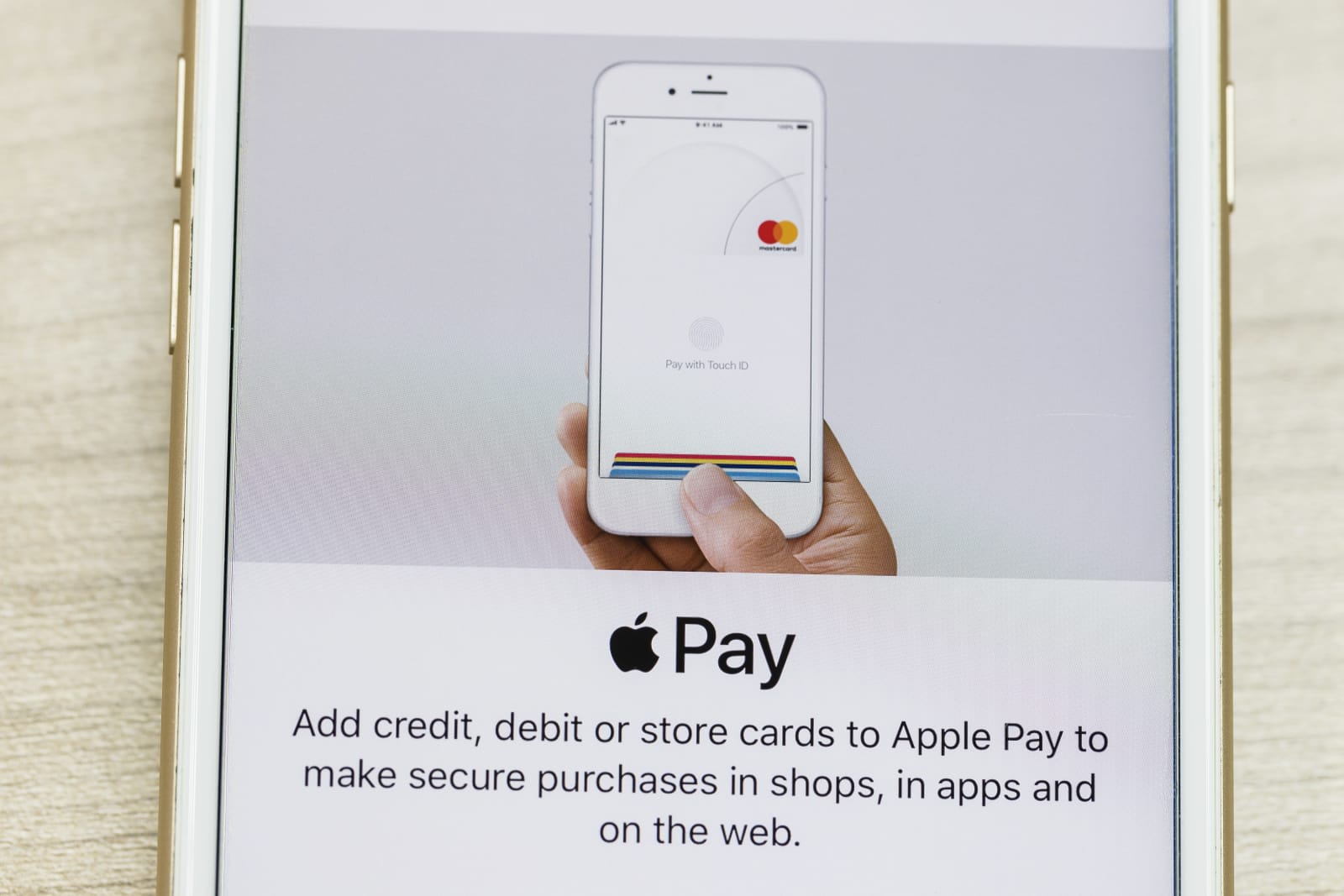MARCH: CBD JELLY BEANS, LEONARDO DOES A HOUDINI, RALPH IS NOT WITH LAUREN AND MORE!

FOOD
The Creator Of Jelly Belly Released A Line Of CBD-Infused Jelly Beans
Content Courtesy of: delish.com
Written by: MAYA MCDOWELL

Regular jelly beans are a fun, fruity treat, but how about CBD-infused ones? David Klein, the genius behind Jelly Belly jelly beans, has given the chewy candy a 2019 makeover with Spectrum Confections—a line of jelly beans infused with cannabidol (CBD). Now these are some jelly beans I'd want to find in an Easter egg!
Klein sold his rights to Jelly Belly in 1980, according to Cannabis Aficionado, but candy has still been on his mind. After recently realizing the benefits of CBD, he asked himself "is anybody doing a jelly bean with CBD?" he told the outlet. He couldn't find any, and he saw an opportunity to create candy again that could help people.
Spectrum Confections, Klein's company, produces CBD-infused jelly beans in 38 different flavors. He says that strawberry cheesecake is one of his favorites and other flavors include toasted marshmallow, piña colada, cinnamon, spicy licorice, and mango. According to the website, each jelly bean has 10 mg of CBD and is sanded with dextrose to mask the CBD flavor.
The beans come in sugar-free and sour varieties, too. Klein is definitely onto something here, because the CBD jelly beans are currently out of stock. The website says to use the contact form or email the company for information on where to buy the Spectrum Jelly Beans.
In a reply to a comment on Facebook, Spectrum Confections wrote, "we are the manufacturer and only sell bulk units to distributors. We are seeing our vendors sell for approximately $2.00 per jelly bean with 10mg." So, keep your eyes peeled for the CBD jelly beans!
We reached out to the company for more information regarding availability and when the jelly beans may be back in stock online. We will update as we hear back.
ART
A Leonardo Made a $450 Million Splash. Now There’s No Sign of It.

Content Courtesy of: nytimes.com
Written by: David D. Kirkpatrick
ABU DHABI, United Arab Emirates — The Louvre Abu Dhabi might seem to have all you could ask for in a world-class museum. Its acclaimed design shades its galleries under a vast dome that appears to hover over the waters of the Persian Gulf. Inside are works by Rembrandt and Vermeer, Monet and van Gogh, Mondrian and Basquiat.
Yet the work that the Louvre Abu Dhabi once promised would anchor its collection is conspicuously absent: “Salvator Mundi,” a painting of Jesus Christ attributed to Leonardo da Vinci.
Few works have evoked as much intrigue, either in the world of art or among the courts of Persian Gulf royals. First, its authenticity as the product of Leonardo’s own hand was the subject of intense debate. Then, in November 2017, it became the most expensive work ever sold at auction, fetching $450.3 million from an anonymous bidder who turned out to be a close ally and possible stand-in for the ruler of Saudi Arabia, Crown Prince Mohammed bin Salman.
Now, the painting is shrouded in a new mystery: Where in the world is “Salvator Mundi”?
Although the Abu Dhabi culture department announced about a month after the auction that it had somehow acquired “Salvator Mundi” for display in the local Louvre, a scheduled unveiling of the painting last September was canceled without explanation. The culture department is refusing to answer questions. Staff of the Louvre Abu Dhabi say privately that they have no knowledge of the painting’s whereabouts.
New York Art Galleries: What to See Right Now
Gilles Aillaud’s portraits of zoo animals; Paul Mpagi Sepuya’s homoerotic photographs; Christina Forrer’s paintings on a loom; and the BRIC Biennial’s third South Brooklyn Edition.

Gilles Aillaud
Through May 11. Ortuzar Projects, 9 White Street, Manhattan; 212-257-0033, ortuzarprojects.com.For decades, American art students have learned that the years around 1968 saw the triumph of conceptual art, process-based sculpture, environmental interventions and body-oriented performances — and only now, at half a century’s distance, are we admitting that figurative painting had its place too in the late-60s art world, especially in Western Europe. Gilles Aillaud (1928-2005) was a central actor of Narrative Figuration during Paris’s years of student revolt, as well as a set designer at Europe’s top avant-garde theaters. But “Paintings 1964-1976,” with eight coolly composed portraits of animals in zoos, is the first showcase of his works in New York since a show at Gladstone Gallery in 1982.
Aillaud and two other young painters stormed to scandalous prominence in 1965 with the collective series “Live and Let Die, or the Tragic Death of Marcel Duchamp,” which pictured the young French artists assassinating the father figure of the avant-garde. (They were also, by symbolically murdering a Frenchman who’d become an American citizen, spitting on contemporary Parisian envy of the New York School.) By 1967 Aillaud had turned to zoos, and before and after the student uprising he painted tortoises, rhinos, porcupines and pythons under heat lamps or beside industrial pipes. In a bare blue cage we see two soporific lions, their eyes vacant, their fur painted with aloof strokes of white. Two hippopotamuses, their thick skin evenly rendered in bronze and burnt umber, float in an aquarium like corpses. The animals never do anything in these zoo paintings. They don’t even meet our gaze; they just laze about on concrete and cinder blocks. It is a stifled view, conversant with the 19th-century tradition of animalier painting, but stripped of any allegorical comfort.
Back in left-wing Paris 50 years ago, Aillaud’s silent, unconsoling art appeared as the antithesis of gestural American abstraction, offering the most alienated view of an industrial capitalist society. They may be more moving today, in an era of climate emergency, when no distinction holds between the natural the man-made. JASON FARAGO
Paul Mpagi Sepuya
Through April 13. Team Gallery, 83 Grand Street, Manhattan; 212-279-9219, teamgal.com.

Paul Mpagi Sepuya's “Darkroom Mirror” (2017) in his show “The Conditions” at Team Gallery.
Paul Mpagi Sepuya is experiencing a flush of success right now, and his new show — “The Conditions,” at Team Gallery — demonstrates that it is well deserved. His work appears on the cover of Artforum’s March issue and will be included in the 2019 Whitney Biennial. Mr. Sepuya is not an overnight sensation, however; over a decade of working, exhibiting and returning to art school to study with the great photographer Catherine Opie at the University of California, Los Angeles helped him to arrive at a distinctive and timely amalgam of portraiture and conceptual photography.
Mr. Sepuya’s photographs are like visual puzzles. He appears in many of them, but in fragmented form and usually with a camera in hand. Some of the works show multiple hands holding cameras, suggesting that authorship is always some sort of collaboration. Pushing that out further, you, the viewer are reflected against the dark backdrops in the picture and if you photograph Mr. Sepuya’s works (as I of course did), your hand and camera end up nestled surprisingly amid the gesturing fingers of him and his subjects.
“The Conditions” could refer to lighting, studio setups, or social conditions. Mr. Sepuya’s photographs have often been categorized as “queer” (that is, within the lesbian, gay, bisexual and transgender cosmos), but they feel more universal to me: Multifarious shades of melanin are represented, and he has included images of women in this show. And while the history of representing bodies in photography — particularly nude ones — is fraught, Mr. Sepuya charges intrepidly into the mire, offering what feel like new, smart conclusions on how to represent power or vulnerability, as well as the unwavering desire to look at such images. MARTHA SCHWENDENER
Christina Forrer
Through April 13. Luhring Augustine, 531 West 24th Street, Manhattan; 212-206-9100, luhringaugustine.com.

Christina Forrer's “Untitled (green background),” from 2018.
Making pictures on a loom, as the Swiss-born, Los Angeles-based artist Christina Forrer does, instead of on canvas or paper, checks a couple of interesting boxes automatically. It invokes the serious feminist art project of reclaiming “women’s work” and at the same time it lampoons the contemporary art world’s infatuation with digital media. A tapestry is a reminder that French artisans mastered pixelation, as well as a kind of analog coding, a good 500 years before the internet.
The way Ms. Forrer does it, flinging loose clusters of marauding, Muppet-like figures across backgrounds of bold color and complex pattern, also tempers the pictures’ importance as pictures. Not that you don’t still look first at the purple girl with enormous green eyes in “Three Awake,” for example. It’s just that the rich patch of indigo you’ll subsequently notice in the piece’s upper left corner is equally significant.
Another way to put it would be to say that Ms. Forrer’s woven sprites and the rich but indistinct worlds they inhabit all seem of a piece, which lends her scenes of giddy mayhem an appropriately dreamlike quality. Some of the nearly 20 characters that inhabit the 10-foot-tall “Untitled (brown background)” issue from others’ mouths, and it’s impossible to tell whether the whole bunch of them are meant to be flying, falling or frozen in place, whether they’re fighting one another to the death or just desperately holding on. WILL HEINRICH
BRIC Biennial: Volume III, South Brooklyn Edition
Through April 7. Gallery at BRIC House, 647 Fulton Street, Brooklyn; 718-683-5600, bricartsmedia.org.

Installation view of the BRIC Biennial. In the foreground, “Chasing Their Ponytails” (2016-18) by the sisters Lisa and Janelle Iglesias, a.k.a. Las Hermanas Iglesias.
In 2014, the arts organization BRIC inaugurated its biennial, an attempt to survey Brooklyn artists by neighborhoods. Flawed though it is, with a focus on geography that can seem arbitrary, the endeavor has proved valuable at spotlighting some of the borough’s abundant creativity.
“BRIC Biennial: Volume III, South Brooklyn Edition,” which features 19 artists and six satellite shows, is a satisfyingly cohesive rumination on dislocation. Katya Grokhovsky focuses on her 93-year-old Jewish grandmother, who survived World War II and immigrated from post-Soviet Ukraine to Australia. She tells her stories in Ms. Grokhovsky’s absorbing video, “The Future Is Bright,” (2018) which screens opposite a sculpture whose explosiveness suggests the impossibility of encapsulating a life.
Other artists take a more formal approach. Jordan Nassar collaborates with traditional Palestinian embroiderers on patterned landscapes that delicately entwine his Palestinian and American identities. The sisters Lisa and Janelle Iglesias, a.k.a. Las Hermanas Iglesias, live on different coasts and worked back and forth on the sculpture “Chasing Their Ponytails” (2016-18), which looks like a quirky contraption for decontextualizing everyday items.
In Brooklyn, any exhibition about displacement would be incomplete without confronting harsh realities. Fortunately, Connie Kang and Danielle Wu, two members of An/Other, an arts advocacy group for Asians, have curated “Virtual and Real Estate,” a small but mighty show in an adjacent gallery. The centerpiece is Betty Yu’s deeply researched inquiry into the gentrification of Sunset Park. Her earnest urgency is counterbalanced by bitingly clever contributions from Daniel Bejar and Pastiche Lumumba, whose “Woke Gentrifyer Starter Pack” (2019) skewers the New Yorker-reading, nonprofit-working, dog-owning liberal. For many Brooklyn art viewers, this may be where the BRIC Biennial hits closest to home. JILLIAN STEINHAUER
ADVERTISING
Hot And Newest Commercials On Tv From Google, Bodyarmor, Bank Of America And More
Content Courtesy of: adage.com
Every weekday we bring you the Ad Age/iSpot Hot Spots, new TV commercials tracked by iSpot.tv, the TV ad measurement and attribution company. The ads here ran on national TV for the first time yesterday.
Ralph Lauren Features A Same-Sex Couple In A Campaign For First Time
Brand is trying to attract new generations of consumers
Content Courtesy of: adage.com
Written by: Adrianne Pasquarelli
Ralph Lauren is finally getting woke to diversity. The apparel brand checks all the boxes in a new ad campaign that features an Asian family, a black family, multiple generations of ages, and a lesbian couple. This is Ralph Lauren's first campaign featuring a same-sex couple, according to a spokeswoman.
"We live in a world where the meaning of family is bigger, broader and more personal than it has ever been before," Jonathan Bottomley, chief marketing officer at the New York retailer, said in a statement. "We believe that family is one of the most positive forces and powerful unifiers for all of us today," he added, noting that the campaign is a "fresh expression of that idea."
The 52-year-old company has been trying to attract younger consumers. In the most recent third quarter, Ralph Lauren increased its marketing investment by 18 percent compared with the year-earlier period. Net revenue for the quarter was $1.7 billion, a 5 percent rise over the year-earlier period.
All of the eight families featured in the brand's new "Family is who you love" campaign are real people, not paid actors. The campaign, which includes outdoor, print, digital and social marketing, was created internally. It will run from April through June.
McDonald’s African-American Marketing Gets Biggest Overhaul In 16 Years
The messaging refresh kicks off this weekend in sync with the NAACP Image Awards
Content Courtesy of: adage.com
Written by:

McDonald's newest ads aren't about some value meal, fancy burger or the ability to order for delivery via a mobile app. They're the kickoff of the biggest overhaul to the restaurant chain's African-American marketing in 16 years.
The updated marketing and community outreach show how the largest restaurant chain aims to deepen its ties with African-American customers, particularly millennials. A spokeswoman declined to reveal how much the chain will spend on the effort but called it "one of our biggest priorities of this year."
"What we've done is really refresh the approach to the engagement in order to be more resonant with the African-American consumer today," says Lizette Williams, McDonald's USA's head of cultural engagement and experiences. Black & Positively Golden, she says, "focuses on stories of truth, power and pride and really is a celebration of black excellence."

Black & Positively Golden, which is focused on education, empowerment and entrepreneurship, replaces the 365Black platform that McDonald's began using in 2003.
It includes a 60-second spot set to air twice during the March 30 broadcast of the 50th Annual NAACP Image Awards. The spot was directed by longtime commercial and film director Joe Pytka and is meant to have a bit of a documentary or "fly on the wall" feel, says Williams. It features people including a Black Marine and feel-good moments such as a woman receiving a giant check for a $10,000 college scholarship from the brand. McDonald's will also give out a Black & Positively Golden award at the NAACP Image Awards, the first time it has had a branded award and gets to select the recipient.
The social media push will be through a new Instagram channel, @wearegolden. The prior program hadn't posted to its @365Black Twitter account since December when it celebrated Herman Petty, who became the chain's first African-American franchisee in 1968. There are now 300 African-American franchisees running more than 1,500 McDonald's restaurants.
Print ads will run in publications including Essence. Radio ads are also part of the push.
McDonald's is seeing solid sales growth but needs to get more customers into its restaurants. Sales at longstanding U.S. restaurants rose 2.5 percent last year, despite a 2.2 percent decline in visits to those locations. Williams joined McDonald's in early 2018 in a new role as the company tries to build brand devotion among multicultural customers. Last year, for example, it expanded its Hacer scholarship program for Hispanic students to 30 winners from five.
McDonald's is broadening its support of the YWCA on a national level after offering some local support. The push includes a year of financial support for the YWCA's Women's Empowerment 360 Program, which helps women of color who aspire to be entrepreneurs. On Friday, it's hosting an event at a YWCA in Los Angeles' Leimert Park neighborhood, where participants can help complete a mural by artist Enkone, and see actress Yvonne Orji (Molly on HBO's "Insecure") and a performance by singer Normani.
McDonald's also says it will continue to provide scholarships for students attending historically black colleges and universities through its partnership with the Thurgood Marshall College Fund.
Burrell Communications, which has worked with McDonald's on campaigns featuring African-Americans since 1972, developed and worked on 365Black is now working on Black & Positively Golden.
Along with Burrell, Walton Isaacson is handling activations including the brand's presence at BETX and Essence Festival. Other plans include the continuation of the McDonald's Inspiration Celebration Gospel Tour, which brings the brand to venues including African-American churches. Faith Based Communications is working on the gospel tour.
TECH
New Apple's Credit Card
Content Courtesy of: engadget.com
Written by: Saqib Shah
Of course, the Apple Pay card will integrate with Apple's Wallet app bringing with it extra features including money, debt, and rewards management tools. Execs may borrow visuals from Apple's Health app, including "rings" that track your daily spend and notifications that alert you if you go over your set money targets.
Goldman, meanwhile, is hoping the venture will attract Apple's loyal fanbase to its Marcus online bank. It's reportedly splashing $200 million on the card's back end infrastructure, from customer-support call centers to an internal system to handle payments. Cardholder perks will apparently include cash back of about 2 percent on most purchases and possibly even more on Apple's devices and services, which the tech giant is set to expand courtesy of an incoming news subscription service and a video streaming platform. The card will use Mastercard's payment network, which is second only to Visa in the US, according to WSJ.
CULTURE
One Small Step For Man, But Women Still Have To Leap
Content Courtesy of: bbc.com
Written by: Chris Bell

Nasa has cancelled plans for its first all-female spacewalk this Friday, citing a lack of available spacesuits in the right size.
There are not enough suits configured on the International Space Station for both Christina Koch and Anne McClain to go out at the same time, so male astronaut Nick Hague will replace Lt Col McClain.
Last week, Lt Col McClain went on a spacewalk with Col Hague and learned that a medium-sized spacesuit fitted her best.
However, Nasa said in a statement: "Because only one medium-size torso can be made ready by Friday 29 March, Koch will wear it."
For many women working in science, a choice between using equipment designed for men or missing out altogether is all too familiar.
Jessica Mounts is a biologist. For more than a decade she worked in freshwater fisheries science for the Kansas Department of Wildlife, Parks and Tourism. She is now the executive director of the Kansas Alliance for Wetlands and Streams.
She noted Nasa's missed milestone with disappointment, but she was not necessarily surprised.

"Representation matters everywhere," she told the BBC.
"The first female spacewalk was both historically significant and inspiring to young girls, like my 10-year-old niece, who dreams of eventually going to space.
"If we can't provide women the equipment they need to do their jobs as astronauts, scientists or first responders, how can we expect to make progress towards equal representation?
"How can women represent a full range of career choices to the next generation of young girls, when we're held back by something as simple as equipment and clothing that fits?"
Pink trim
Jessica's work means she is frequently in rivers or lakes, in all weathers, to monitor and evaluate fish populations. She has often been, she says, "the only woman on the boat".
"Most of the equipment I've used has been designed for men. The problems caused aren't simply an annoyance - they all go back to personal safety.
"Clothing that is too loose gets caught in moving equipment. Boots that are too big mean tripping and falling.
"The alternatives that are 'designed for women' are frequently more expensive, have smaller pockets, are still ill-fitting and most likely have just been copies of the male version with a little pink added to the trim."
Jessica shared her frustrations on Twitter and she was far from alone in her experiences.
There was the biostatistician with a PhD in quantitative genetics, who could not find safety goggles that fit properly when working in the lab with chemicals.
Jessica was also tweeted by a biologist who could not get the steel toe-capped boots she needed for field work outside, and a neuroscientist who said she "passed out from overheating" because the only surgical gowns available for teaching were in "six-foot tall man" sizes and had to be wrapped around her three times.
And it is not only the scientific world where women must frequently make do. Caroline Criado Perez is a feminist, journalist and author of Invisible Women: Exposing Data Bias in a World Designed for Men.
"We don't collect data on women and therefore we don't design things for women," she told the BBC's Jeremy Vine show on Wednesday.
"We think of male bodies and typical male life patterns as the default for humans overall, and so women are disadvantaged as a result.
"Spacesuits are the tip of the iceberg. When you look at personal protective equipment - stab vests, safety goggles, safety boots, all those kinds of clothes and tools that people are supposed to use to protect themselves at work, a lot of the time they don't fit women."
Jessica says things are improving, but the pace of change is slow.
"As more women enter the field, things have improved marginally.
"Waders made in women's sizes are now available and there are some designs of personal flotation devices made to accommodate breasts. That said, we have a long way to go.
"Historically, science and similar fields have been dominated by men and the systemic culture of our society continues to support that narrative.
"When only men are allowed to work, the only equipment available is made for them. When women want to work, the equipment isn't there and is a tangible symbol of the greater issue of systemic sexism in a society designed, in general, by and for men."
K-Pop is a reality
Content Courtesy of: bbc.com
Written by: BBC News Staff

US toymaker Mattel has unveiled a collection of BTS dolls and it is fair to say the response has been mixed.
Fans of the K-Pop super group have set the internet aflame with fevered discussion of the South Korean boy band's miniature effigies.
Since the first images of the dolls were released on Monday, the online army of BTS fans have propelled the toymaker's name into the top global Twitter trends.
And while much of the reaction has been supportive, more than a few are less than happy with what they have seen.
Mattel had been teasing the dolls' release for weeks, but their introduction to the world left some a little underwhelmed.
And the reaction memes kept on coming.

Most complaints seemed to centre around the dolls' hair.
Others were remarkably concerned with the boy band's bottom line, keen to discourage criticism and avoid putting off "future investors".
Many fans simply felt the criticism was rude.
While some compared them favourably to another high-profile boy band doll partnership.
Mattel's collaboration with BTS was announced in January.
"BTS is a pop-culture music phenomenon that transcends age, culture and language," Sejal Shah Miller, Mattel's senior vice president and global brand manager, said.
"Through this partnership, Mattel will offer a new way for millions across the world to engage with the band."
There's certainly been plenty of engagement online.
Bohemian Censored
Content Courtesy of: bbc.com
Written by: Chris Bell and Kerry Allen

Oscar-winning Freddie Mercury biopic Bohemian Rhapsody was released in China on Friday, but references to the Queen singer's sexuality and AIDS diagnosis were censored.
Several minutes of footage were edited out of the film, including scenes of two men kissing and the word "gay".
There has been significant reaction to the film's release online. More than 50,000 users have posted reviews on Sina Weibo, China's Twitter-like micro-blogging platform.
Though some users complained of "half watching and half guessing" as a result of the deleted scenes, others were pleased the film had been released at all.
What was removed?
In the Chinese version of the film, several scenes have been amended or deleted.
Explicit and implicit references to Mercury's sexuality were edited out, including an important scene in which he comes out to his then-girlfriend.
Other scenes to be removed include a close-up of Mercury's crotch as he performs, interactions with his male partner Jim Hutton and the entire sequence in which the character and his onscreen band-mates recreate Queen's iconic music video for 1984 single I Want to Break Free, in which they dress in women's clothes.
What was the reaction?
Thousands of Chinese social media users have been sharing reviews of the film online.
Most have been positive, with more than 80% of social media users to post reviews on Weibo awarding the film five stars out of five. However, there has been notable criticism of the revisions.
"If there were no deleted scenes it would have been better," one Weibo user wrote.
"Why is it necessary to delete gay-related content? Doesn't a person's life... deserve to be complete?"
"It's really good that Bohemian Rhapsody is being screened in the mainland," said another. "But the plot was broken because of deleted scenes."
Why was it censored?
Homosexuality has been legal in China for more than two decades and the Chinese Society of Psychiatry removed it from the country's classification of mental disorders in 2001. But the movie's censorship was widely anticipated.
In recent years, Chinese authorities have embarked on a campaign to purge content it deems inappropriate. Explicit references to same-sex relationships are banned under Chinese regulations. Gay content is frequently removed or censored by Chinese media anxious to ensure compliance.
In February, broadcaster Mango TV's Oscars coverage was heavily criticised after it amended a reference to homosexuality in the acceptance speech of Rami Malek, who plays Freddie Mercury in Bohemian Rhapsody. The same outlet was condemned in 2018 for censoring rainbow flags and tattoos in its broadcast of the Eurovision Song Contest.
At the beginning of this year, another streaming service, iQiyi, was mocked for blurring the earlobes of men wearing earrings in what many observers interpreted as a heavy-handed attempt to perpetuate "traditional" gender roles.













